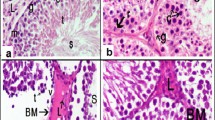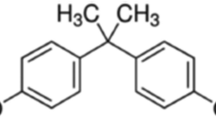Abstract
The aim of this study was to investigate the positive effects of decursin and decursinol angelate (D/DA) on the reproductive system of male rats as well as to examine whether D/DA is able to ameliorate the effects of bisphenol A (BPA). Adult rats were divided into the following four groups: (1) control, (2) BPA, (3) D/DA, and (4) BPA+D/DA. Organ weight ratio of vital organs decreased in the kidney (9.5%) and increased in the prostate (24.07%) and epididymis (22.14%) in the BPA+D/DA group compared to the values in the BPA group. A significant decrease (P<0.05) in sperm count was found in the BPA+D/DA (18.91%) and BPA(54.05%) groups compared to the count in the control group. In only D/DA (20.14%) group, sperm count was significantly increased. D/DA ameliorated the histopathological changes induced by BPA in the testis, consistent with these data. D/DA was also identified as promoting the activities of antioxidant enzymes such as catalase (CAT) and glutathione peroxidase (GPx), the levels of which were significantly increased compared to the corresponding levels in the BPA group. Fas/FasL (FAS) and caspase-3 (CAP) levels were significantly decreased in rats. The results suggest that D/DA reduces apoptosis of Leydig and germ cells in the mouse testis through the Fas-signaling pathway.
Similar content being viewed by others
References
Jurewicz, J., Hanke, W., Radwan, M. & Bonde, J. P. Environmental factors and semen quality. Int J Occup Med Env 22:305–329 (2009).
dE Luis, O. & del Mazo, J. Gene expression of mouse M1 and M2 pyruvate kinase isoenzymes correlates with differential poly[A] tract extension of their mRNAs during the development of spermatogenesis. Biochim Biophys Acta 1396:294–305 (1998).
Šutiaková, I., Kovalkovičová, N., Tulenková, M. & Šutiak, V. Bisphenol A and its potential toxic effects on living organisms. J Microb Biotechnol Food Sci 2:526–535 (2012).
Li, Y. J. et al. Bisphenol A Exposure Induces Apoptosis and Upregulation of Fas/FasL and Caspase-3 Expression in the Testes of Mice. Toxicol Sci 108:427–436 (2009).
Ahn, M. J., Lee, M. K., Kim, Y. C. & Sung, S. H. The Simultaneous determination of coumarins in Angelica gigas root by high performance liquid chromatographydiode array detector coupled with electrospray ionization/mass spectrometry. J Pharmaceut Biomed 46:258–266 (2008).
Konoshima, M., Chi, H. J. & Hata, K. Coumarins from The root of Angelica gigas Nakai. Chem Pharm Bull 16:1139–1140 (1968).
Ryu, K. S., Hong, N. D., Kim, N. J. & Kong, Y. Y. Studies on the coumarin constituents of the root of Angelica gigas Nakai. Isolation of decursinol angelate and assay of decursinol angelate and decursin. Kor J Pharmacogn 21:64–68 (1990).
Yook, C. S. Coloured medicinal plants of Korea, Academy Book Co., Seoul, 390 (1990).
Lee, S. H. et al. Anti-tumor activities of decursinol angelate and decursin from Angelica gigas. Arch Pharm Res 26:727–730 (2003).
Lee, S. H. et al. Antibacterial courmins from Angelica gigas roots. Arch Pharm Res 26:449–452 (2003).
Yim, D. S., Singh, R. P., Agarwal, C., Lee, S. Y. & Chi, H. J. A novel anticancer agent, decursin, induces G1 arrest and apoptosis in human prostate carcinoma cells. Cancer Res 65:1035–1044 (2005).
Kang, S. Y., Lee, K. Y., Sung, S. H., Park, M. J. & Kim, Y. C. Coumarins isolated from Angelica gigas inhibit acetylcholinesterase structure-activity relationships. J Nat Prod 64:683–685 (2001).
Ahn, K. S., Sim, W. S. & Kim, I. H. Decursin: a cytotoxic agent and protein kinase C activator from the root of Angelica gigas. Planta Med 62:7–9 (1996).
Kim, S. J. et al. Preliminary Report on the Safety of a New Herbal Formula and Its Effect on Sperm Quality. World J Mens Health 31:254–261 (2013).
Kim, K. M. et al. Evaluation of the Genotoxicity of Decursin and Decursinol Angelate Produced by Angelica gigas Nakai. Mol Cell Toxicol 5:83–87 (2009).
Kim, K. M., Lee, Y. J., Hong, Y. G. & Kang, J. S. Oral Acute and Subacute Toxicity Studies of Decursin and Decursinol Angelate of Angelica gigas Nakai. Mol Cell Toxicol 5:153–159 (2009).
Ashby, J. et al. The Effect on Sperm Production in Adult Sprague-Dawley Rats Exposed by Gavage to Bisphenol A between Postnatal Days 91–97. Toxicol Sci 74:129–138 (2003).
Takahashi, O. & Oishi, S. Testicular toxicity of dietary or parenterally administered bisphenol A in rats and mice. Food Chem Toxicol 41:1035–1044 (2003).
Zhou, D. X. et al. The protective effect of vitamin E against oxidative damage caused by formaldehyde in the testes of adult rats. Asian J Androl 8:584–588 (2006).
Vosoughi, S. et al. Effects of Simultaneous Exposure to Formaldehyde Vapor and Noise on Mouse Testicular Tissue and Sperm Parameters. J Health Scope 1:110–117 (2012).
Son, C. Y. et al. Pharmacological Effect of Decursin and Decursinol Angelate from Angelica gigas Nakai. J Kor Pharm Sci 53:303–313 (2009).
Nagel, S. C. et al. Relative binding affinity-serum modified Access (RBA-SMA)assay predicts the relative in vivo bioactivity of the xenoestrogens bisphenol A and octylphenol. Environ Health Persp 105:70–76 (1997).
Mohammad, N. et al. Vitamins C, E and lipid peroxidation levels in sperm and seminal plasma of asthenoteratozoospermic and normozoospermic men. Iran J Reprod Med 6:1–5 (2008).
Aitken, R. J. & Fisher, H. Reactive oxygen species generation and human spermatozoa: the balance of benefit and risk. Bioassays 16:259–267 (1994).
Tarafder, P., Sarkar, K., Nath, P. & Paul, G. Inhibition of heart ventricular function of rat by bisphenol A through oxidative stress induced injury of ventricular tissue. Int J Pharm Bio Sci 4:811–820 (2013).
Rekha, D. K. et al. Role of vitamin C as an antioxidant in cadmium chloride induced testicular damage. Int J Appl Biol Pharm Techno 2:484–488 (2011).
Takahashi, O. & Oishi, S. Testicular toxicity of dietary 2,2-bis(4-hydroxyphenyl)propane (bisphenol A) in F344 rats. Arch Toxicol 75:42–51 (2001).
Al-Hiyasat, A. S., Darmani, H. & Elbetieha, A. M. Effects of bisphenol A on adult male mouse fertility. Eur J Oral Sci 110:163–167 (2002).
Sakaue, M. et al. Bisphenol A affects spermatogenesis in the adult rat even at a low dose. J Occup Health 43:185–190 (2001).
Kim, K. M. et al. Isolation and purification of decursin and decursinol angelate in Angelica gigas Nakai. J Korean Soc Food Sci Nutr 38:653–656 (2009).
WHO, Research guidelines for evaluating the safety and efficacy or herbal medicines. Regional office for the western pacific working group on the safety and efficacy on herbal medicine. Manila, Philippines, 5–9 (1992).
Akhtar, N., Srivastava, M. K. & Raizada, R. B. Assessment of chlorpyrifos toxicity on certain organs in rat, Rattus norvegicus. J Environ Biol 30:1047–1053 (2009).
Author information
Authors and Affiliations
Corresponding author
Rights and permissions
About this article
Cite this article
Kim, K.M., Seo, J.L. & Kang, J.S. Decursin and decursinol angelate affect spermatogenesis in the adult rat at oral administration. Mol. Cell. Toxicol. 10, 83–89 (2014). https://doi.org/10.1007/s13273-014-0010-2
Received:
Accepted:
Published:
Issue Date:
DOI: https://doi.org/10.1007/s13273-014-0010-2




